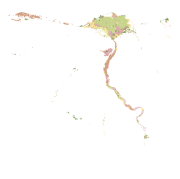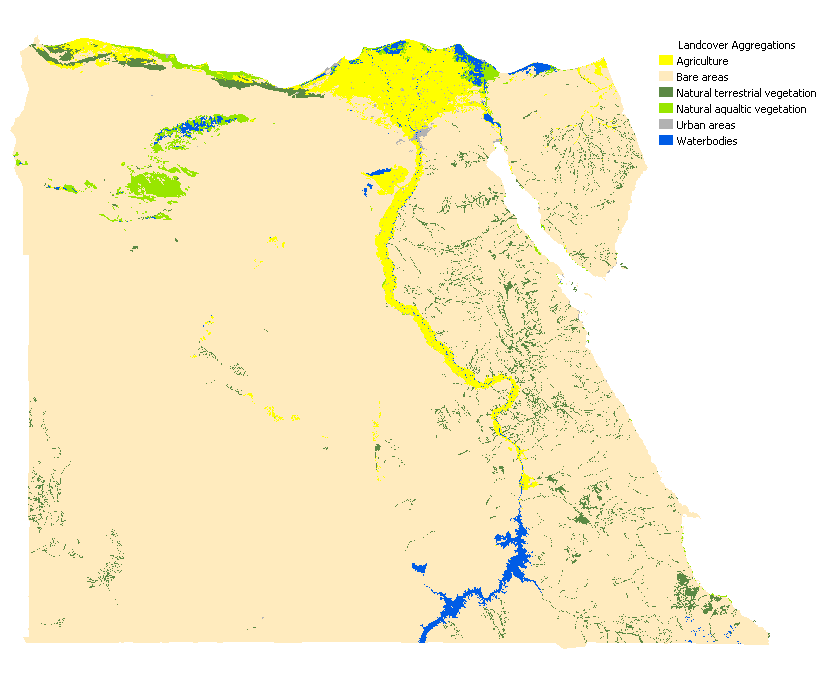desert
Type of resources
Available actions
Topics
Keywords
Contact for the resource
Provided by
Formats
Representation types
Update frequencies
status
Scale
-

This dataset is a thematic reaggregated version of the original national Africover landcover multipurpose database. It contains all cultivated areas. The original full resolution land cover has been produced from visual interpretation of digitally enhanced LANDSAT TM images (Bands 4,3,2) acquired mainly in the year 1997 (see the "Multipurpose Landcover Database" metadata for more details). This dataset is intended for free public access. Thematic aggregation is the way that the end user customizes the Africover database to fulfil his/her specific requirements. The Africover database gives equal level of detail to Agriculture as well as Natural vegetation or Bare Areas etc. Generally a single user does not need this level of detail for each class type; therefore he/she will enhance the information of one land cover type and will generalize or erase the information related to other land cover aspects. The most powerful way to conduct an aggregation exercise is to use the classifiers as basic elements of the exercise. This gives the user the maximum flexibility on the use of data. The shape main attributes correspond to the following fields: -ID -HECTARES -CULTID -CULT_DESC You can download a zip archive containing: -the eg-bare-areas-agg (.shp) -the Egypt Classifiers Used (.pdf) -the Egypt legend (.pdf and .xls) -the Egypt Legend - LCCS Import file (.xls) -the LCCSglossary_egypt (.pdf) -the thematic-aggregation-procedure (.pdf) -the thematic-aggregation-annex1 (.pdf) -the thematic-aggregation-annex2 (.pdf) -the Userlabel Definitions (.pdf)
-
This dataset is a thematic reaggregated version of the original national Africover landcover multipurpose database. It contains all bare areas. The original full resolution land cover has been produced from visual interpretation of digitally enhanced LANDSAT TM images (Bands 4,3,2) acquired mainly in the year 1997 (see the "Multipurpose Landcover Database" metadata for more details). This dataset is intended for free public access. Thematic aggregation is the way that the end user customizes the Africover database to fulfil his/her specific requirements. The Africover database gives equal level of detail to Agriculture as well as Natural vegetation or Bare Areas etc. Generally a single user does not need this level of detail for each class type; therefore he/she will enhance the information of one land cover type and will generalize or erase the information related to other land cover aspects. The most powerful way to conduct an aggregation exercise is to use the classifiers as basic elements of the exercise. This gives the user the maximum flexibility on the use of data. The shape main attributes correspond to the following fields: -ID -HECTARES -BA_ID -BA_DESC You can download a zip archive containing: -the eg-bare-areas-agg (.shp) -the Egypt Classifiers Used (.pdf) -the Egypt legend (.pdf and .xls) -the Egypt Legend - LCCS Import file (.xls) -the LCCSglossary_egypt (.pdf) -the thematic-aggregation-procedure (.pdf) -the thematic-aggregation-annex1 (.pdf) -the thematic-aggregation-annex2 (.pdf) -the Userlabel Definitions (.pdf)
-
This dataset is a thematic reaggregated version of the original national Africover landcover multipurpose database. It contains all natural vegetation. The original full resolution land cover has been produced from visual interpretation of digitally enhanced LANDSAT TM images (Bands 4,3,2) acquired mainly in the year 1997 (see the "Multipurpose Landcover Database" metadata for more details). This dataset is intended for free public access. Thematic aggregation is the way that the end user customizes the Africover database to fulfil his/her specific requirements. The Africover database gives equal level of detail to Agriculture as well as Natural vegetation or Bare Areas etc. Generally a single user does not need this level of detail for each class type; therefore he/she will enhance the information of one land cover type and will generalize or erase the information related to other land cover aspects. The most powerful way to conduct an aggregation exercise is to use the classifiers as basic elements of the exercise. This gives the user the maximum flexibility on the use of data. The shape main attributes correspond to the following fields: -ID -HECTARES -NV_ID -NV_DESC You can download a zip archive containing: -the eg-nat-veg-agg (.shp) -the Egypt Classifiers Used (.pdf) -the Egypt legend (.pdf and .xls) -the Egypt Legend - LCCS Import file (.xls) -the LCCSglossary_egypt (.pdf) -the thematic-aggregation-procedure (.pdf) -the thematic-aggregation-annex1 (.pdf) -the thematic-aggregation-annex2 (.pdf) -the Userlabel Definitions (.pdf)
-

This dataset is a spatially reaggregated version of the original national Africover multipurpose database. The original full resolution land cover has been produced from visual interpretation of digitally enhanced LANDSAT TM images (Bands 4,3,2) acquired mainly in the year 1997. The data was aggregated by eliminating polygons below a certain area threshold. This threshold corresponds to approx. a 30 % reduction in the polygon count. The dataset was then re-aggregated based on area threshold values. For more information on the area thresholds used to spatially aggregate the land cover database, please see the 'spatial-agg-procedure' document included in the zip file here available for download. The land cover classes have been developed using the FAO/UNEP international standard LCCS classification system. The data set is intended for free public access. The shape main attributes correspond to the following fields: -ID -HECTARES -USERLABEL -LCCCODE (unique LCCS code) -CODE1 -CODE2 -CODE3 -LC You can download a zip archive containing: -the dataset eg-spatial-agg (.shp) -the Egypt Classifiers Used (.pdf) -the Egypt legend (.pdf and .xls) -the Egypt Legend - LCCS Import file (.xls) -the spatial-agg-procedure (.pdf) -the Userlabel Definitions (.pdf) Note: the document Egypt Classifiers Used.pdf, is a list of all the LCCS classifiers used in the study area. They are grouped under the 8 major land cover types. In addition to the standard classifiers contained in LCCS the user may find “user defined†classifiers used by the map producer to add additional information to a specific class, not available in LCCS. The user-defined attributes are always coded with the letter “Zâ€.
 FAO Map Catalog
FAO Map Catalog